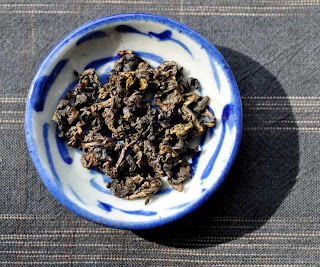Pat and Jason have shown a lot of passion and motivation in learning about Chinese/Taiwanese tea culture. And when 2 more distinguished guests joined them, I decided to take them to one of the nicest place to brew tea: outdoors, in the mountains of Tucheng!
Professor Jae-Sup Park, Ph. D (left) and Yasuo Koike (right) joined their 2 American tea friends and a European tea blogger (me) for this international tea summit!
Professor Park teaches Korean Studies at the Inje University in Korea. And Mr. Koike is a retired Japanese journalist with a great interest in tea (his wife is a Japanese tea master in NYC).
So, to expand their understanding of Taiwanese teas, I had the pleasure of brewing several Oolongs with my silver kettle!
I started with my winter 2011 Shan Lin Shi Luanze oolong. They were very pleased with its sweetness and long aftertaste. In Japan and Korea, high quality green teas are mostly harvested in spring (twice), so they were very surprised to taste a winter harvest. The examination of the open leaves also proved very unusual for them: whole and big mountain leaves!
Then, I proceeded to brew my spring 2012 Da Yu Ling Luanze Oolong. This made the difference between winter and spring Oolongs very obvious. This tea displayed its amazing clarity and high, natural fragrances. The silver teapot strengthened the crisp, clear taste. (Later, we brewed this tea with a zhuni teapot and found that the hard Yixing clay gave more body and a more mellow aftertaste.)
With just these 2 high mountain Oolongs, we could enjoy very light, but powerful and fine brews. Sharing this pleasure through our faces didn't need many words. The tea was speaking its own direct language to us.
A natural breeze helped power the charcoal in my white Nilu at a relaxed speed. Like all tea accessories, the more often you use your Nilu, the better you understand it. The time it takes for the water to boil tells you the strength of the fire and you learn to add charcoal earlier if you want more heat for a faster boil. But adding charcoal can also reduce your heat if your piece of charcoal is big and covers the fire! Like with brewing tea, it's a matter of paying attention and learning from past mistakes/successes.
We now proceed to one of my charcoal roasted Shan Lin Shi Hung Shui Oolong. Everybody is amazed of the difference of aromas between the leaves in the foil and in the jar. "The oolong smells stronger and finer in the jar!", observed professor Park.
The Hung Shui Oolong tasted deeper and more complex than the unroasted Oolongs. A rich golden color brew combines the fragrant scents with the sweet and nutty notes of a medium roast. The mellow aftertaste unfolds by waves and seems never to go away...
I can see my guests are true tea connaisseurs who know how to appreciate the quality of my teas! So, I reward them with my 1990 San Hsia Hung Shui Oolong! This 22 years Oolong hasn't been reroasted. It wasn't necessary, because it has been very well stored. I'm using fewer leaves than with my newer Oolongs, but the brew still comes out darker!
Mr. Koike is amazed by the freshness of this tea. It reminds him Japanese green tea: "I can taste unami", he said with a smile!
We were all moved by this tea. Time has chiseled the aromas with increasing clarity and depth.
The hard zhuni clay extracts high notes with precision. It proved to be a perfect match for this old Oolong!
Update: I'm adding a picture of the 22 years old Oolong leaves we brewed in Tucheng.




























































